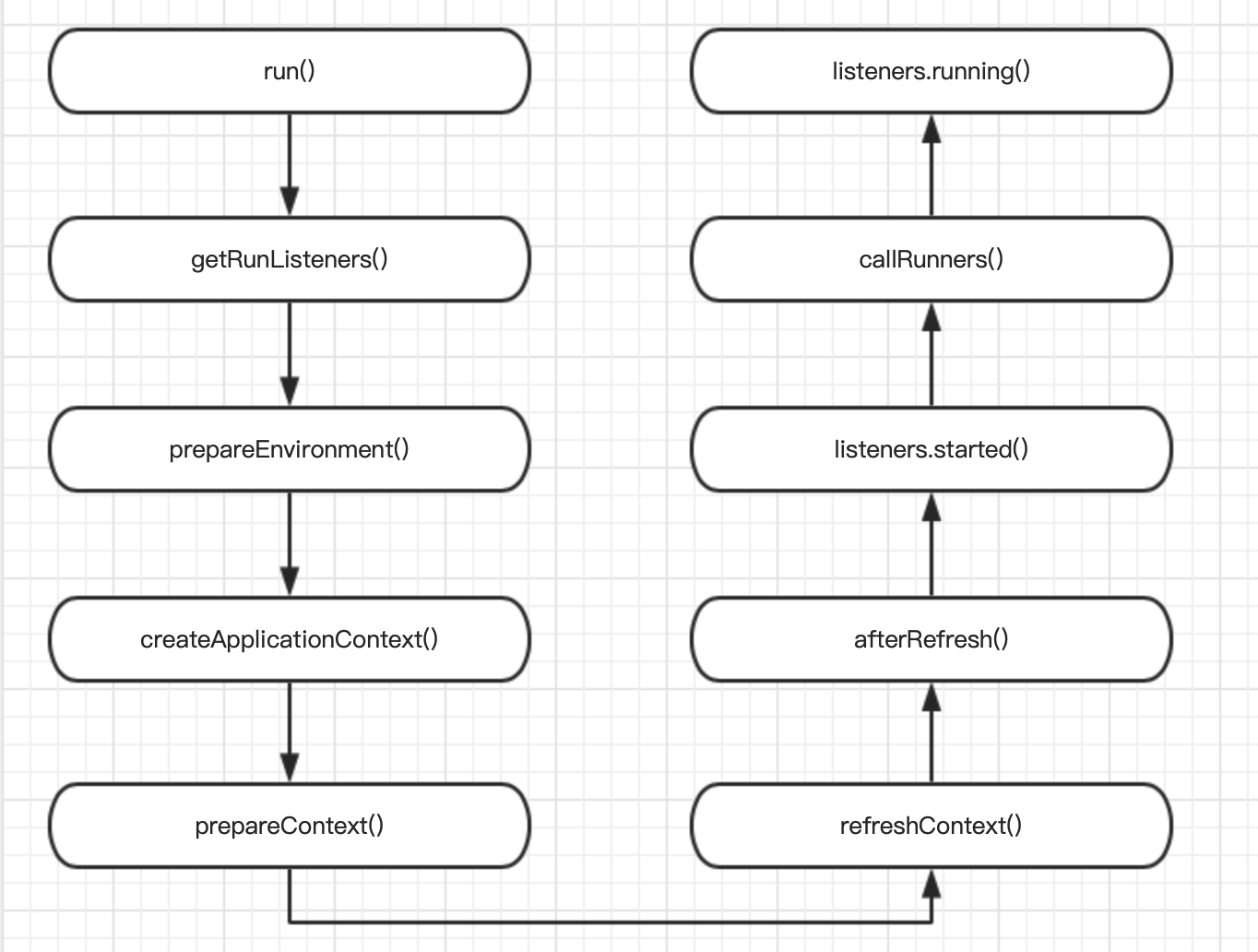Spring Boot源码分析-启动过程
Spring Boot作为目前最流行的Java开发框架,秉承“约定优于配置”原则,大大简化了Spring MVC繁琐的XML文件配置,基本实现零配置启动项目。
本文基于
Spring Boot 2.1.0.RELEASE版本了解Spring Boot如何启动
首先让我们看一下最简单的Spring Boot启动代码
@SpringBootApplicationpublic class DemoApplication {public static void main(String[] args) {SpringApplication.run(DemoApplication.class, args);}}
每一个使用过Spring Boot的同学对于上面的代码应该都非常熟悉了,通过这段代码即可启动Spring Boot应用。那么SpringApplication.run(DemoApplication.class, args)内部到底做了什么事情呢?
在查看具体代码之前,我们先了解一下SpringApplication内部大概的执行流程,如下图

从上图中可以看出run()是整个应用的入口,接着初始化SpringApplicationRunListener,Environment等实例,然后创建应用上下文对象,“准备”并“刷新”上下文,到这里Spring容器已基本启动完成,最后发送事件通知各个组件作出相应动作。
源码分析
在了解完大概的流程之后,下面开始深入源码分析Spring Boot具体的启动过程,首先进入入口方法run
public ConfigurableApplicationContext run(String... args) {StopWatch stopWatch = new StopWatch();stopWatch.start();ConfigurableApplicationContext context = null;Collection<SpringBootExceptionReporter> exceptionReporters = new ArrayList<>();configureHeadlessProperty();SpringApplicationRunListeners listeners = getRunListeners(args);listeners.starting();// ...
StopWatch主要是用来统计每项任务执行时长,例如Spring Boot启动占用总时长。
Started DemoApplication in 4.241 seconds (JVM running for 5.987)
getRunListeners()完成了SpringApplicationRunListener实例化工作,如何完成的呢?进入方法内部查看
private SpringApplicationRunListeners getRunListeners(String[] args) {Class<?>[] types = new Class<?>[] { SpringApplication.class, String[].class };return new SpringApplicationRunListeners(logger, getSpringFactoriesInstances(SpringApplicationRunListener.class, types, this, args));}
SpringApplicationRunListeners和SpringApplicationRunListener不是同一个类,它们名称非常相似
查看SpringApplicationRunListeners源码
SpringApplicationRunListeners(Log log,Collection<? extends SpringApplicationRunListener> listeners) {this.log = log;this.listeners = new ArrayList<>(listeners);}public void starting() {for (SpringApplicationRunListener listener : this.listeners {listener.starting();}}public void environmentPrepared() {// ....}public void contextPrepared() {// ....}public void contextLoaded() {// ....}public void started() {// ....}public void running() {// ....}
它是
SpringApplicationRunListener的一个集合
观察SpringApplicationRunListeners所有方法,可以看出,它实际是一个用来发送SpringApplicationRunListener相关事件的工具类
接着继续观察getSpringFactoriesInstances源码,看它是如何实例化对象的(此方法后续多处使用)
private <T> Collection<T> getSpringFactoriesInstance(Class<T> type,Class<?>[] parameterTypes, Object... args) {ClassLoader classLoader = getClassLoader();// 加载对象名称Set<String> names = new LinkedHashSet<>(SpringFactoriesLoader.loadFactoryNames(type,classLoader));List<T> instances = createSpringFactoriesInstances(type parameterTypes,classLoader, args, names);AnnotationAwareOrderComparator.sort(instances);return instances;}
这里通过SpringFactoriesLoader.loadFactoryNames获取type对应的FactoryNames,不明白有什么用处?进入方法内部查看
public static List<String> loadFactoryNames(Class<?>factoryClass, @Nullable ClassLoader classLoader) {String factoryClassName = factoryClass.getName();return loadSpringFactories(classLoader).getOrDefaul(factoryClassName, Collections.emptyList());}
继续进入loadSpringFactories方法内部
public static final String FACTORIES_RESOURCE_LOCATION ="META-INF/spring.factories";private static Map<String, List<String>> loadSpringFactorie(@Nullable ClassLoader classLoader) {MultiValueMap<String, String> result = cache.ge(classLoader);if (result != null) {return result;}try {// 获取 META-INF/spring.factories 对应的资源Enumeration<URL> urls = (classLoader != null ?classLoader.getResource(FACTORIES_RESOURCE_LOCATION) :ClassLoader.getSystemResource(FACTORIES_RESOURCE_LOCATION));result = new LinkedMultiValueMap<>();while (urls.hasMoreElements()) {URL url = urls.nextElement();UrlResource resource = new UrlResource(url);// 读取文件内容Properties properties =PropertiesLoaderUtils.loadProperties(resource);for (Map.Entry<?, ?> entry : properties.entrySe()) {String factoryClassName = ((String)entry.getKey()).trim();for (String factoryName :StringUtils.commaDelimitedListToStringArray(String) entry.getValue())) {// 获取 factoryClassName 对应的多个valu(多个value用逗号分隔)result.add(factoryClassName,factoryName.trim());}}}// 缓存已经读取到的内容cache.put(classLoader, result);return result;}catch (IOException ex) {throw new IllegalArgumentException("Unable to loadfactories from location [" +FACTORIES_RESOURCE_LOCATION + "]", ex);}}
看到这里可能会疑惑META-INF/spring.factories文件在哪里?文件里面有什么内容?
其实这个文件存放在Spring Boot和Spring Boot autoconfigure的jar包内部(有兴趣的同学可以自行下载jar包并解压查看),Spring Boot中的文件内容如下:
# 完整内容请查看原文件# Run Listenersorg.springframework.boot.SpringApplicationRunListener=\org.springframework.boot.context.event.EventPublishingRunListener# Application Listenersorg.springframework.context.ApplicationListener=\org.springframework.boot.ClearCachesApplicationListener,\org.springframework.boot.builder.ParentContextCloserApplicationListener,\org.springframework.boot.context.FileEncodingApplicationListener,\org.springframework.boot.context.config.AnsiOutputApplicationListener,\org.springframework.boot.context.config.ConfigFileApplicationListener,\org.springframework.boot.context.config.DelegatingApplicationListener,\org.springframework.boot.context.logging.ClasspathLoggingApplicationListener,\org.springframework.boot.context.logging.LoggingApplicationListener,\org.springframework.boot.liquibase.LiquibaseServiceLocatorApplicationListener
可以看到SpringApplicationRunListener对应的值是EventPublishingRunListener
回到SpringFactoriesLoader.loadFactoryNames方法内部,可以发现方法获取的值实际上是factoryClass在META-INF/spring.factories中对应的实现类的集合
明白这个方法之后,再回到getSpringFactoriesInstances方法
private <T> Collection<T> getSpringFactoriesInstance(Class<T> type,Class<?>[] parameterTypes, Object... args) {ClassLoader classLoader = getClassLoader();// 获取 SpringApplicationRunListener 对应的实现类的名称集合Set<String> names = new LinkedHashSet<>(SpringFactoriesLoader.loadFactoryNames(type,classLoader));// 通过反射实例化对象List<T> instances = createSpringFactoriesInstances(type parameterTypes,classLoader, args, names);AnnotationAwareOrderComparator.sort(instances);return instances;}
到此为止getRunListeners完成了SpringApplicationRunListener对应实现类的实例化,并回调其starting方法
SpringApplicationRunListeners listeners getRunListeners(args);listeners.starting();
从上面分析得知,实际上调用的是EventPublishingRunListener的starting方法,那么方法内部做了什么呢?
public void starting() {this.initialMulticaster.multicastEvent(new ApplicationStartingEvent(this.application,this.args));}
发送了一个ApplicationStartingEvent事件
继续查找ApplicationStartingEvent事件的消费者,从spring.factories中可以找到所有预定义的事件消费者
# Application Listenersorg.springframework.context.ApplicationListener=\org.springframework.boot.ClearCachesApplicationListener,\org.springframework.boot.builder.ParentContextCloserApplicationListener,\org.springframework.boot.context.FileEncodingApplicationListener,\org.springframework.boot.context.config.AnsiOutputApplicationListener,\org.springframework.boot.context.config.ConfigFileApplicationListener,\org.springframework.boot.context.config.DelegatingApplicationListener,\org.springframework.boot.context.logging.ClasspathLoggingApplicationListener,\org.springframework.boot.context.logging.LoggingApplicationListener,\org.springframework.boot.liquibase.LiquibaseServiceLocatorApplicationListener
# Application Listenersorg.springframework.context.ApplicationListener=\org.springframework.boot.autoconfigure.BackgroundPreinitializer
接下来要做的就是从这些消费者中找出ApplicationStartingEvent事件的消费者(查找过程省略),找到以下两个消费者
LoggingApplicationListener
初始化日志系统LiquibaseServiceLocatorApplicationListener
(参数liquibase.servicelocator.ServiceLocator)如果存在,则使用springboot相关的版本进行替代
了解完ApplicationStartingEvent事件之后,回到run方法继续往下探究prepareEnvironment
private ConfigurableEnvironment prepareEnvironment(SpringApplicationRunListeners listeners,ApplicationArguments applicationArguments) {// 创建Environment对象ConfigurableEnvironment environment =getOrCreateEnvironment();configureEnvironment(environment,applicationArguments.getSourceArgs());// 发布ApplicationEnvironmentPreparedEvent事件listeners.environmentPrepared(environment);bindToSpringApplication(environment);if (!this.isCustomEnvironment) {environment = new EnvironmentConverte(getClassLoader()).convertEnvironmentIfNecessary(environment,deduceEnvironmentClass());}ConfigurationPropertySources.attach(environment);return environment;}
这里又发布了一个ApplicationEnvironmentPreparedEvent事件,继续查找事件监听对象
- FileEncodingApplicationListener
检查系统文件编码格式是否符合环境变量中配置的文件编码格式(如果存在相关设置 - spring.mandatory-file-encoding),如果编码不符合,则抛出异常阻止Spring启动 - AnsiOutputApplicationListener
是否开启AnsiOutput - DelegatingApplicationListener
代理context.listener.classes配置的监听者 - ClasspathLoggingApplicationListener
日志输出classpath - LoggingApplicationListener
配置日志系统,logging.config, logging.level...等 - ConfigFileApplicationListener
这是一个比较重要的监听对象,具体的方法实现如下
private void onApplicationEnvironmentPreparedEvent(ApplicationEnvironmentPreparedEvent event) {List<EnvironmentPostProcessor> postProcessors =loadPostProcessors();postProcessors.add(this);AnnotationAwareOrderComparator.sort(postProcessors);for (EnvironmentPostProcessor postProcessor :postProcessors) {postProcessor.postProcessEnvironmen(event.getEnvironment(),event.getSpringApplication());}}List<EnvironmentPostProcessor> loadPostProcessors() {return SpringFactoriesLoader.loadFactorie(EnvironmentPostProcessor.class,getClass().getClassLoader());}
通过spring.factories,可以看到这里加载以下EnvironmentPostProcessor对象
- CloudFoundryVcapEnvironmentPostProcessor
- SpringApplicationJsonEnvironmentPostProcessor
- SystemEnvironmentPropertySourceEnvironmentPostProcessor
- ConfigFileApplicationListener
很多同学可能会疑问ConfigFileApplicationListener并不存在spring.factories文件中,这里为什么会有它呢?
实际上ConfigFileApplicationListener在onApplicationEnvironmentPreparedEvent方法中,将自身添加到EnvironmentPostProcessor对象列表中。
我们主要关注ConfigFileApplicationListener的postProcessEnvironment方法
public void postProcessEnvironment(ConfigurableEnvironmentenvironment,SpringApplication application) {addPropertySources(environment,application.getResourceLoader());}protected void addPropertySources(ConfigurableEnvironmentenvironment,ResourceLoader resourceLoader) {RandomValuePropertySource.addToEnvironment(environment);// 读取applicaiton.yml, application.properties等配置文件new Loader(environment, resourceLoader).load();}
ConfigFileApplicationListener监听到ApplicationEnvironmentPreparedEvent事件之后开始读取本地配置文件
关于Spring如何读取本地配置文件,请前往Spring Boot源码分析-配置文件加载原理
创建ApplicationContext对象
protected ConfigurableApplicationContextcreateApplicationContext() {Class<?> contextClass = this.applicationContextClass;if (contextClass == null) {try {// 根据webApplicationType创建对应上下文对象switch (this.webApplicationType) {case SERVLET:contextClass = Class.forNam(DEFAULT_SERVLET_WEB_CONTEXT_CLASS);break;case REACTIVE:contextClass = Class.forNam(DEFAULT_REACTIVE_WEB_CONTEXT_CLASS);break;default:contextClass = Class.forNam(DEFAULT_CONTEXT_CLASS);}}catch (ClassNotFoundException ex) {throw new IllegalStateException("Unable create a defaultApplicationContext, "+ "please specify anApplicationContextClass",ex);}}return (ConfigurableApplicationContext)BeanUtils.instantiateClass(contextClass);}
这里是根据webApplicationType决定创建什么类型的ApplicationContext对象,那么webApplicationType是何时赋值的呢?
public SpringApplication(ResourceLoader resourceLoader,Class<?>... primarySources) {this.resourceLoader = resourceLoader;Assert.notNull(primarySources, "PrimarySources must notbe null");this.primarySources = new LinkedHashSet<>(Arrays.asLis(primarySources));// 初始化webApplicationTypethis.webApplicationType =WebApplicationType.deduceFromClasspath();setInitializers((Collection) getSpringFactoriesInstance(ApplicationContextInitializer.class));setListeners((Collection) getSpringFactoriesInstance(ApplicationListener.class));this.mainApplicationClass = deduceMainApplicationClass(;}
从上面可以看出是通过WebApplicationType.deduceFromClasspath方法初始化的webApplicationType,继续跟踪代码
private static final String WEBFLUX_INDICATOR_CLASS = "org."+ "springframework.web.reactive.DispatcherHandler";private static final String WEBMVC_INDICATOR_CLASS = "org.springframework."+ "web.servlet.DispatcherServlet";private static final String JERSEY_INDICATOR_CLASS = "org.glassfish.jersey.servlet.ServletContainer";private static final String[] SERVLET_INDICATOR_CLASSES = { "javax.servlet.Servlet","org.springframework.web.context.ConfigurableWebApplicationContext" };static WebApplicationType deduceFromClasspath() {if (ClassUtils.isPresent(WEBFLUX_INDICATOR_CLASS, null)&& !ClassUtils.isPresent(WEBMVC_INDICATOR_CLASS null)&& !ClassUtils.isPresent(JERSEY_INDICATOR_CLASS null)) {return WebApplicationType.REACTIVE;}for (String className : SERVLET_INDICATOR_CLASSES) {if (!ClassUtils.isPresent(className, null)) {return WebApplicationType.NONE;}}return WebApplicationType.SERVLET;}
从上面代码中可以看出Spring是通过当前classpath下是否存在相应的类,从而决定webApplicationType类型
初始化ApplicationContext对象
private void prepareContext(ConfigurableApplicationContextcontext,ConfigurableEnvironment environment,SpringApplicationRunListeners listeners,ApplicationArguments applicationArguments, BannerprintedBanner) {// 初始化contextcontext.setEnvironment(environment);postProcessApplicationContext(context);applyInitializers(context);// 发送ApplicationContextInitializedEvent消息listeners.contextPrepared(context);if (this.logStartupInfo) {logStartupInfo(context.getParent() == null);logStartupProfileInfo(context);}// Add boot specific singleton beansConfigurableListableBeanFactory beanFactory =context.getBeanFactory();beanFactory.registerSingleto("springApplicationArguments", applicationArguments);if (printedBanner != null) {beanFactory.registerSingleton("springBootBanner",printedBanner);}if (beanFactory instanceof DefaultListableBeanFactory) {((DefaultListableBeanFactory) beanFactory).setAllowBeanDefinitionOverridin(this.allowBeanDefinitionOverriding);}Set<Object> sources = getAllSources();Assert.notEmpty(sources, "Sources must not be empty");// 注册DemoApplicationload(context, sources.toArray(new Object[0]));listeners.contextLoaded(context);}
这里注册了DemoApplication到Spring容器中,为后续bean扫描做准备
接下来继续深入refreshContext方法,可以发现实际上是执行了AbstractApplicationContext.refresh方法
public void refresh() throws BeansException,IllegalStateException {synchronized (this.startupShutdownMonitor) {prepareRefresh();ConfigurableListableBeanFactory beanFactory =obtainFreshBeanFactory();prepareBeanFactory(beanFactory);try {postProcessBeanFactory(beanFactory);// 完成bean的加载invokeBeanFactoryPostProcessors(beanFactory);registerBeanPostProcessors(beanFactory);initMessageSource();initApplicationEventMulticaster();onRefresh();registerListeners();finishBeanFactoryInitialization(beanFactory);finishRefresh();}catch (BeansException ex) {if (logger.isWarnEnabled()) {logger.warn("Exception encountered duringcontext initialization - " +"cancelling refresh attempt: " + ex;}destroyBeans();cancelRefresh(ex);throw ex;}finally {resetCommonCaches();}}}
refresh方法内部做了很多事情。比如:完成BeanFactory设置,BeanFactoryPostProcessor、BeanPostProcessor接口回调,Bean加载,国际化配置等。
到此为止Spring基本完成了容器的初始化工作,最后在调用callRunners方法,执行ApplicationRunner、CommandLineRunner接口。
private void callRunners(ApplicationContext context,ApplicationArguments args) {List<Object> runners = new ArrayList<>();runners.addAll(context.getBeansOfTyp(ApplicationRunner.class).values());runners.addAll(context.getBeansOfTyp(CommandLineRunner.class).values());AnnotationAwareOrderComparator.sort(runners);for (Object runner : new LinkedHashSet<>(runners)) {if (runner instanceof ApplicationRunner) {callRunner((ApplicationRunner) runner, args);}if (runner instanceof CommandLineRunner) {callRunner((CommandLineRunner) runner, args);}}}
整个启动过程的核心方法是refresh,此方法内部承载大部分容器启动所需的工作。由于篇幅原因,后续再进行refresh内部源码分析,了解Spring Boot加载Bean的整个过程。
本文由博客一文多发平台 OpenWrite 发布!
Spring Boot源码分析-启动过程的更多相关文章
- Spring Boot源码分析-配置文件加载原理
在Spring Boot源码分析-启动过程中我们进行了启动源码的分析,大致了解了整个Spring Boot的启动过程,具体细节这里不再赘述,感兴趣的同学可以自行阅读.今天让我们继续阅读源码,了解配置文 ...
- 精尽Spring Boot源码分析 - SpringApplication 启动类的启动过程
该系列文章是笔者在学习 Spring Boot 过程中总结下来的,里面涉及到相关源码,可能对读者不太友好,请结合我的源码注释 Spring Boot 源码分析 GitHub 地址 进行阅读 Sprin ...
- 精尽Spring Boot源码分析 - Jar 包的启动实现
该系列文章是笔者在学习 Spring Boot 过程中总结下来的,里面涉及到相关源码,可能对读者不太友好,请结合我的源码注释 Spring Boot 源码分析 GitHub 地址 进行阅读 Sprin ...
- 精尽Spring Boot源码分析 - 序言
该系列文章是笔者在学习 Spring Boot 过程中总结下来的,里面涉及到相关源码,可能对读者不太友好,请结合我的源码注释 Spring Boot 源码分析 GitHub 地址 进行阅读 Sprin ...
- 精尽Spring Boot源码分析 - 文章导读
该系列文章是笔者在学习 Spring Boot 过程中总结下来的,里面涉及到相关源码,可能对读者不太友好,请结合我的源码注释 Spring Boot 源码分析 GitHub 地址 进行阅读 Sprin ...
- 精尽Spring Boot源码分析 - 内嵌Tomcat容器的实现
该系列文章是笔者在学习 Spring Boot 过程中总结下来的,里面涉及到相关源码,可能对读者不太友好,请结合我的源码注释 Spring Boot 源码分析 GitHub 地址 进行阅读 Sprin ...
- 精尽Spring Boot源码分析 - 支持外部 Tomcat 容器的实现
该系列文章是笔者在学习 Spring Boot 过程中总结下来的,里面涉及到相关源码,可能对读者不太友好,请结合我的源码注释 Spring Boot 源码分析 GitHub 地址 进行阅读 Sprin ...
- 精尽Spring Boot源码分析 - 剖析 @SpringBootApplication 注解
该系列文章是笔者在学习 Spring Boot 过程中总结下来的,里面涉及到相关源码,可能对读者不太友好,请结合我的源码注释 Spring Boot 源码分析 GitHub 地址 进行阅读 Sprin ...
- 精尽Spring Boot源码分析 - 配置加载
该系列文章是笔者在学习 Spring Boot 过程中总结下来的,里面涉及到相关源码,可能对读者不太友好,请结合我的源码注释 Spring Boot 源码分析 GitHub 地址 进行阅读 Sprin ...
随机推荐
- mysql: error while loading shared libraries: libnuma.so
安装mysql后,执行初始化配置脚本,创建系统自带的数据库和表时报异常: [root@VM_0_12_centos mysql]# scripts/mysql_install_db --basedir ...
- 如何知道,当前redis实例是处于阻塞状态?
随便get一个key,然后卡着不动就行,简单粗暴.优雅一点是看latency的延迟,blocked_clients的数量,rejected_connections的数量等 或者 方法一:登录 Redi ...
- Remote Ubuntu VM from Windows
Need to install the xrdp tool on Ubuntu. To do this, open a Terminal window (Ctrl + Alt + T) and ent ...
- 在debian下安装QT 5.10 32位
准备工作: 在开始之前最好把GCC升级到5.0以上. 如果升级后出现“libstdc++.so.6: version `CXXABI_1.3.9' not found”错误,可以参考https://b ...
- ffmpeg编码h264设置规格
ffmpeg -i demo.ts -profile:v baseline -vcodec h264 -acodec aac -f flv demo.flv
- 设置Fedora能够使用root用户登录
1. 切换到root工作环境,因为一下操作必须拥有root权限 [ha@localhost ~]$ su root密码: 2. 编辑/etc/pam.d/gdm [root@localhost ha] ...
- Android网络编程之——文件断点下载
一:关于断点下载所涉及到的知识点 1.对SQLite的增删改查(主要用来保存当前任务的一些信息) 2.HttpURLConnection的请求配置 HttpURLConnection connecti ...
- GIT管理以及运行规范
继前天看分享的前后端分离后,又重新研究了GIT分支与各个环境的应用. 从开始使用git就一直有在网上查各种资料,查他的运行规范.但不知道是自己理解不够还是怎么的,一直用得不是很好. 根据自己的摸索,整 ...
- 数据中心网络架构的问题与演进 — 云网融合与 SD-WAN
目录 文章目录 目录 前文列表 云网融合 云网融合的应用场景 SD-WAN SD-WAN 的应用场景 企业组网互联 SD-EN 数据中心互联 SD-DCI 云间互联 SD-CX 企业用户接入云 数据中 ...
- 几句简单的python代码完成周公解梦功能
<周公解梦>是靠人的梦来卜吉凶的一本于民间流传的解梦书籍,共有七类梦境的解述.这是非常传统的中国文化体系的一部分,但是如何用代码来获取并搜索周公解梦的数据呢?一般情况下,要通过爬虫获取数据 ...
